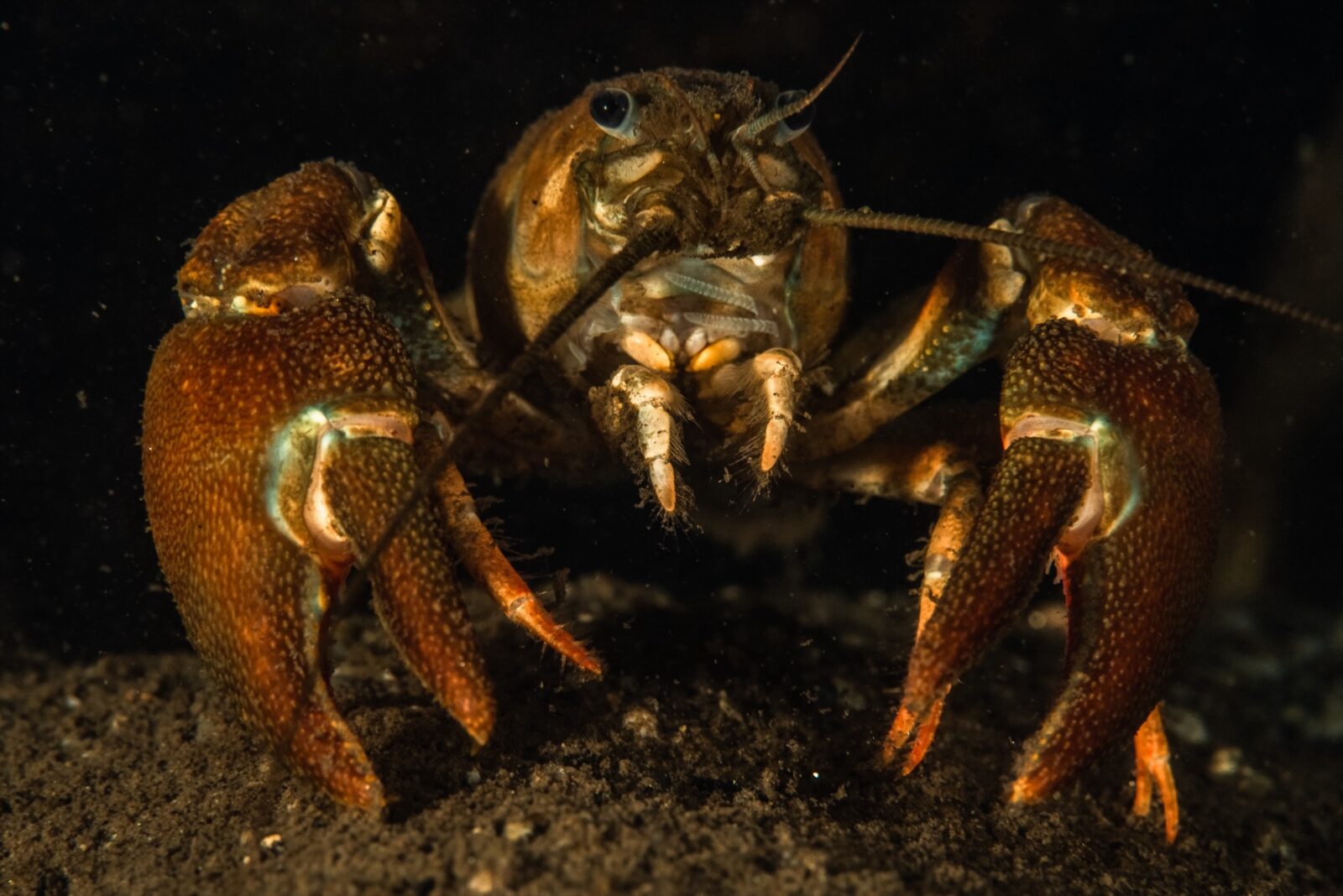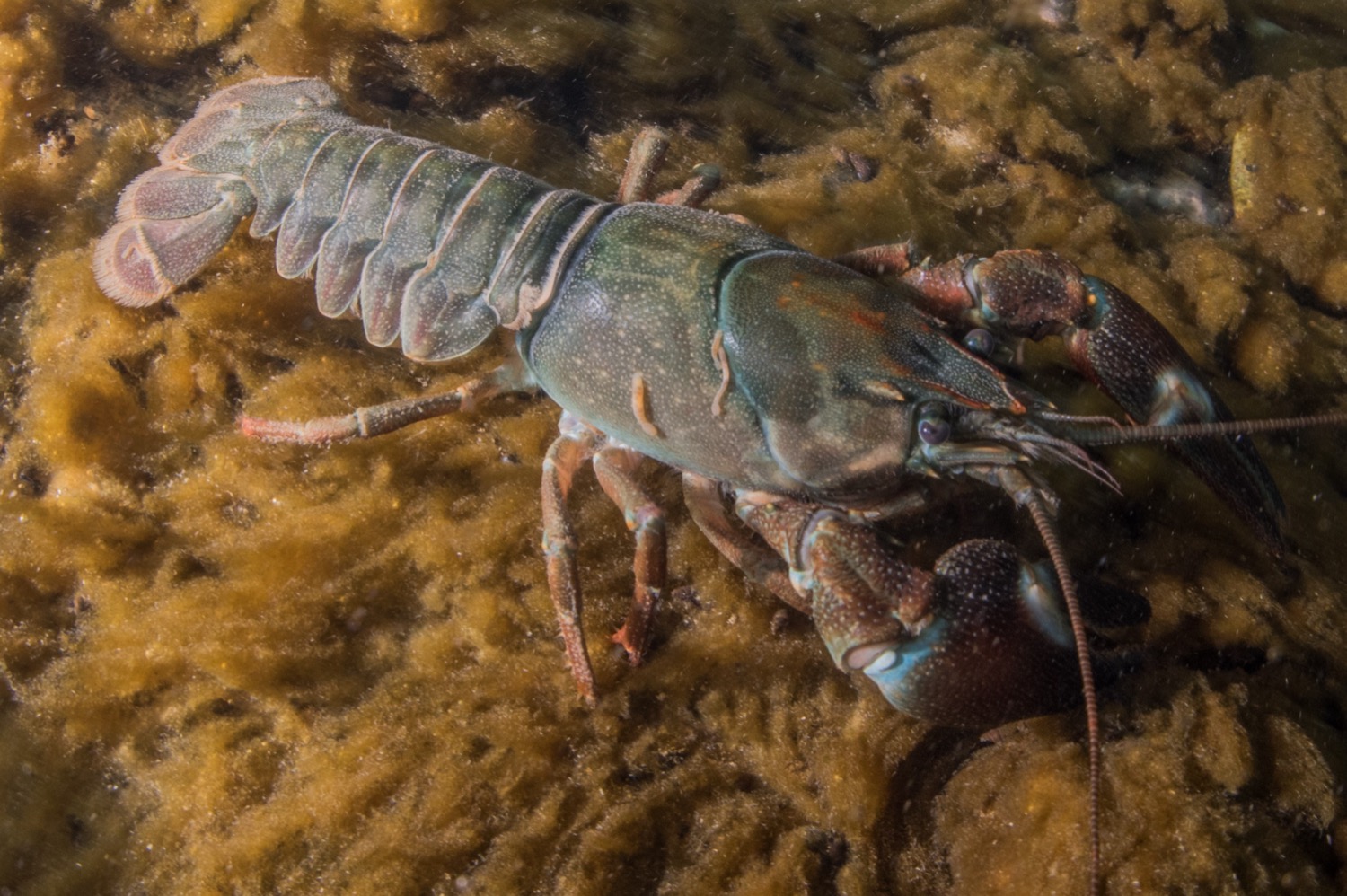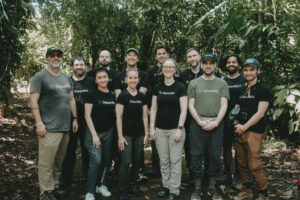
It was about a century ago that we can be sure a sooty crayfish last ambled across the bottom of a Bay Area stream—perhaps in Alameda, or Pescadero Creek, where her kind had once been widespread. There, she might have nibbled on a snail or carefully selected a pebble, nimbly manipulating it in her petite pincers, to tidy the entrance to the tunnel she had excavated in the riverbank.
Perhaps she died peacefully in old age after failing to find a mate. Perhaps she was crushed in a heron’s beak, or by the claws of an invading crayfish species. Maybe she was gradually blanketed and smothered by a layer of choking silt from the canals being built upstream. All we know is that she was the endling—the last surviving member of her species—for sometime after the species was last seen in the late 1800s, the sooty crayfish quietly vanished.
Crayfish, the freshwater counterparts to lobsters, are ubiquitous yet overlooked. Curious children pluck mudbugs, crawdads, or crawfish—all crayfish by another name—from the shallows, sometimes earning a painful pinch as a reward. Others buy them by the bushel to pile high at crayfish boils. “I think people often assume that a crayfish is a crayfish—they’re all the same, a cosmopolitan [species] that lives everywhere on Earth,” says Eric Larson, an ecologist and associate professor at the University of Illinois Urbana-Champaign, who studies crayfish invasions and declines. “That’s not the case.” These humble denizens of the shallows are, in fact, keystone species and ecosystem engineers that play an outsize role in their habitats—and different species can have vastly different impacts.
North America, in fact, is teeming with crayfish biodiversity, with some 400-odd species dwelling from roadside bogs to mountain streams, but most of that diversity is in the southeastern U.S. California—in other respects a biodiversity hotspot—is naturally depauperate in the crayfish department. The whole state had just three native crayfish species, all from the same genus, Pacifastacus: the signal crayfish (P. leniusculus), mainly a Pacific Northwest cray whose natural range barely dipped into CA; the endangered Shasta crayfish (P. fortis), named after its single home county; and the sooty, (P. nigrescens), our only native Bay Area species, which was found nowhere else in the world. And now just two native species remain in California.
The sooty crayfish was almost certainly well known to the Miwok and Ohlone, though the archaeological evidence is scant—crayfish shells are notoriously thin and brittle, and don’t persist for long in middens. But various other crayfish species are recorded as food sources for other Indigenous peoples across North America and elsewhere. The crayfish would have then come to the attention of frontiersmen and settlers, all of whom used it as a food source.
A Western scientist first noticed the sooty in the mid-1850s, a time of explosive population growth for San Francisco and California as thousands of prospectors surged in from the East following the discovery of gold in 1848. William Stimpson, a young biologist surveying the West, stumbled across the crayfish at a fish market in San Francisco. Stimpson remarked on its ‘slender hands lacking pubescence’ (hairs), noted aspects of the chitinous spikes on the exoskeleton that differentiated it from similar species, measured it to be about 3 inches in length, and observed that it was common in the waterways around San Francisco. Stimpson roved across the West and became a renowned marine biologist, describing 948 species. Eventually, he lugged his treasured specimens, including the sooty, to Chicago, taking a job as director of the Chicago Academy of Sciences. The first specimen that a description is based on, called a holotype, was meant to be kept preserved forever so that future generations could refer back to it. Unluckily, the sooty holotype burned in the Great Chicago Fire, with countless other specimens. In retrospect, you could see the tragedy as a portent of the species’ fate.
Ancestors of the sooty crayfish arrived in the San Francisco Bay Area from the north sometime during the Pleistocene—that is, between 2.5 million and 12,000 years ago. A big range, I know. I spent some time trying to narrow it down—but with limited specimens and no fossil records, that would be quite the scientific journey. Anyway, we do know ancestors of the sooty crayfish crawled south through rivers, creeks, and possibly floodwaters from great glacial melt events. When conditions changed, Bay Area crayfish were cut off from other crayfish for millennia. Isolated, they speciated—and along with them, so did their many hitchhikers.

For each crayfish is a world unto itself, a host of tiny passengers. Those plastered on their shells include leech-like crayfish worms (Branchiobdellidans) and bean-shaped seed shrimp (Entocytherids), symbiotic organisms that live on the crayfish, specialize in picking food from their exoskeletons, and rely on their hosts to complete their life cycles. Bronwyn Williams, an invertebrate research curator at the North Carolina Museum of Natural Sciences who researches crayfish and their hangers-on, has seen as many as eight species on a single crayfish, and describes each cray as a complex landscape. She marvels that the tiny creatures “partition themselves into microhabitats on the crayfish, essentially establishing their own little properties. One species may occur on the claws, while another occurs on the underside of the tail.” Crayfish real estate isn’t the only place these micro-critters differ—Williams says “species have wildly different behaviors as well. Some are slow and kind of dopey, some are really fast and squirrelly.” Generally, they’re neither parasites nor freeloaders: one 2020 study on an East Coast species found that crayfish with these symbionts grew faster and were more active than those without. Some of these shell-inhabiting worms and shrimp are happy on any old crayfish, but many are uniquely adapted to life on a single species. We’d need a time machine to examine the symbiotic species that adhered to the sooty’s shell, as even museum specimens weren’t maintained in a way that would have preserved their little passengers. They might have been thrown out during changes of preserving alcohol and formalin, or simply mistaken for disposable gunk at the bottom of a jar. But we can be almost positive that they would have been distinct. To them, the sooty crayfish were a one-stop traveling nursery, buffet, motel, and ultimately—with no new hosts to jump to, a hearse.
After its entrée into the scientific world, the sooty crayfish remained out of the public eye as the world changed around it. San Francisco became the fastest-growing city in North America, and from 1860 to 1920, the population of the Bay Area counties grew tenfold. This rapid urbanization and industrialization brought drastic changes to the watersheds; increased pollution, waterways were drained, filled in, or redirected, expunging the sooty from its former haunts. Remaining individuals were likely shoved to the margins of their habitat.
It’s a globally common pattern, and one I see with Bay Area species of concern that I work with as a wildlife biologist. So many local species only persist in the areas that humans deem undesirable for development. The San Francisco garter snake or Alameda striped racer, both of which lost habitat when the regions rapidly urbanized. The California tiger salamander, which had the bad luck of relying on vernal ponds that were converted to agricultural uses.
The death knell for the sooty crayfish probably sounded with the introduction of its cousin from the north—the signal crayfish. Growing up to 8 inches long, and brandishing beefy pincers, in contrast to the sooty’s delicate appendages, the signal cray was more than twice the sooty’s size. And it was voracious, eating everything the smaller sooty could and more—including, quite likely, the sooties themselves. An early record spotted signal crays in the Bay in 1898, but they seem to have remained sparse for years after that. In 1912 the invasion escalated—with human assistance. People had recognized how delicious crayfish were, and their flavor was their ticket around the world. Signal crayfish were released, probably intentionally, into the San Lorenzo River, near Santa Cruz, from the California Fish and Wildlife Commission’s Brookdale Fish Hatchery. Perhaps the hatchery staff didn’t distinguish between native sooty crayfish and the imported variety they were releasing; perhaps they figured the river already had crayfish in it, so why not add some more? How the signal crayfish made it to nearby waters isn’t clear, but, however, the results are in—today, they’re found in waterways in every Bay Area county. In urban and remote streams alike, the signal crayfish marched in and summarily ate their meeker relatives.


These Bay Area streams, being relatively healthy and undisturbed, are just the sort of places a sooty crayfish might have inhabited a little over a century ago. On the left is Lagunitas Creek in Marin; the right is a North Bay creek bottom where only signal crayfish can be found nowadays. (Anton Sorokin)
And nobody, it seems, did anything to stop them. Combing through public statements, articles and dispatches from freshwater ecologists, naturalists, and state agencies in the early 1900s, I could find no evidence that anyone ever tried to conserve or save the sooty crayfish, or that people even noticed its decline while it was happening. In all likelihood, the vast majority of people who did come across crayfish failed to recognize that there were two distinct species, and one was being replaced by the other. I could see that in the 1800s, the sooty was described as a common creature—and then for some years, the record goes almost dark, until biologists in the mid-1900s started remarking that the sooty was notably missing and had been for some time. Signal crayfish were by then, however, abundant. In the next hundred years, the signal would conquer the entire state of California, and two new invaders would arrive—the virile crayfish (Faxonius virilis), from the Great Lakes region, and the red swamp crayfish (Procambarus clarkii), from Louisiana and Texas.
So in the Bay area, we lost one species of crayfish and gained three. “We may never know what all was lost with the extinction of the sooty crayfish,” Williams says, but this seemingly small shift in crustacean populations likely had major landscape effects.
Crayfish species don’t all behave the same, and they play different roles in their underwater communities. Some dig burrows, like our red swamp crays; others can’t. Some are highly predatory, like the signal cray; others are largely herbivorous. Again and again in our modern age, we’ve seen how non-native species—whether common ivy or crayfish—can take advantage of their new surroundings, when freed from the constraints that kept them in check in their native ranges. They can reach greater densities than they ever did in their native ranges. They cost us millions of dollars a year, and cause many unexpected consequences—some of which may be paid for with blood, literally … The next time you’re swarmed by mosquitoes, invasive crayfish may be the ones to blame. In California, a study linked red swamp crayfish to increased mosquito swarms. Normally, dragonflies keep mosquito populations down, adeptly preying on them at all life stages. But some crayfish, in turn, prey on dragonfly larvae. Hyperabundant invasive crayfish eat most of the dragonflies, and mosquitos flourish. Of course, dragonflies aren’t the only thing being consumed—hordes of invasive crays march around on river bottoms opportunistically eating larvae and eggs of fish and amphibians, many of the same species California spends millions of dollars yearly to conserve. Worldwide, the economic cost of signal crayfish invasions was estimated at nearly $104 million between 2000 and 2020, while the red swamp crayfish, no slouch either, was responsible for another $11.8 million in damages during that period. The researchers who compiled this accounting figured this was most likely a significant underestimate of the true costs.

Native or not, crayfish are busy little mudbugs with an outsize impact. They’re central components of food webs, eating and getting eaten by others—including terrestrial predators (and when a raccoon gets a crawdad feast it’s helping move nutrients from aquatic systems onto land). Retroactively figuring out the exact role the sooties and their symbiont communities played in Bay Area freshwater ecosystems is challenging. “The extinction of a species is far more than the loss of a single biological entity,” Williams says. “In this case we may never know what all has been lost.”
But looking at similar species can give us clues. Burrowing crayfish like the sooty create habitat that is also used by small fish and invertebrates, similar to the role that ground squirrels play on land. The crayfish clip plant roots, move large amounts of soil, and aid gas exchange, by freeing it from soils to areas where it can be used by plants and animals. Native plants and animals evolved alongside the kind of low-grade disturbance the sooties would have provided. Now, introduced crayfish can burrow too—but because there are far more of them than there ever were native crayfish, their out-of-control excavation can destabilize riverbanks, kill aquatic plants, muddy the water, and even change the paths of rivers. When crayfish murk up the waters, other things die or go away—and a cascading reduction in the diversity and abundance of aquatic plants, invertebrates, amphibians, and birds can follow. Some crayfish-rich stretches of a stream in Southern California were found to have a lower aquatic invertebrate diversity, which in turn limited food sources for state threatened steelhead trout and newts.
The sooty’s sad story is a cautionary tale, as other native crayfish in the West are facing the same problems that took it out. “If you don’t want to find these species at the brink of extinction in 2100,” Larson says, “the time to be proactive is now.”
But I wondered. Could sooty crayfish have secretly survived? Better technology, increased public interest, and phones in every hand have led to consistent species rediscoveries. In 2020, an iNaturalist user in the Sierra rediscovered, while gardening, a cicada not seen since 1915. A clam considered extinct since the Pleistocene was found in a tidepool off Santa Barbara’s coast. Even other crayfish have returned from the supposed dead: last year, an Alabama cave crayfish was found after being presumed extinct for more than 30 years. Maybe sooty crayfish dwell out of sight at the bottom of creeks in the Bay Area?
Given the density of crustacean enthusiasts—scientists at universities or museums, other scientists, anglers, and others—Larson doesn’t think so. “It’s not a place where I think biologists or zoologists have been likely to miss this animal for a half-century or more.” But he adds, “If you find an interesting crayfish in the Bay Area, take a photo and upload it to iNaturalist, or send an image to a researcher.” Larson would love, he says, to be proved wrong.




